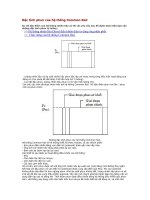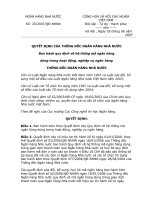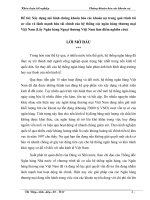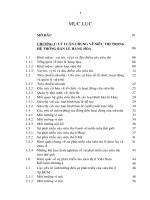Hệ thống common rail hãng BMW
Bạn đang xem bản rút gọn của tài liệu. Xem và tải ngay bản đầy đủ của tài liệu tại đây (1.84 MB, 64 trang )
Diesel Engines
M57/M67 Common Rail
Course contents/Background material
Information status:
09/98
BMW
Service Training
DI Diesel Engines M57/M67 - Common Rail Sec. 1-10
Course contents/Background material
Contents
Page
Sec. 1 Introduction 1
Concepts 3
Engine views 4
Technical features 6
DDE control unit 7
Technical data 7
Exhaust emission legislation 9
Notes on exhaust emission standards/
test cycles 10
Sec. 2 Engine components 1
System structure 1
Component description 2
Engine block 2
Cylinder head gasket 5
Cylinder head 6
Cylinder head cover 8
Valve gear 10
Crankshaft 12
Flywheel 14
Connecting rods with bearings 15
Pistons with rings and pins 17
Chain drive 18
Oil pan 20
Timing case cover (M57) 22
Rear end cover (M67) 22
Sec. 3 Ancillary components and belt drive 1
Brief description 1
Requirements and Objectives 1
System structure 2
Component description 4
Torsional vibration damper 4
Starter motor 5
Alternator 6
A/C compressor 6
Belts 6
Tensioning pulley or idler pulley 7
© BMW AG, Service Training
DI Diesel Engines M57/M67 - Common Rail Sec. 1-10
Course contents/Background material
Sec. 4 Engine mounts 1
Brief description 1
Requirements and Objectives 1
System structure 2
Component description 3
Hydraulic mount 3
Functional description 5
DDE parameters 5
Vacuum supply 6
Sec. 5 Lubrication system 1
Brief description 1
Requirements and Objectives 1
System structure 2
Component description 4
Oil pump 4
Oil filter with integrated oil-to-water
heat exchanger 6
Oil spray nozzles 7
Sec. 6 Cooling system 1
Brief description 1
Requirements and Objectives 1
System structure 2
Component description 4
Water pump 4
Thermostat 4
Radiator 5
Exhaust hood/shutter 7
Fan 7
Auxiliary heater 7
© BMW AG, Service Training
DI Diesel Engines M57/M67 - Common Rail Sec. 1-10
Course contents/Background material
Sec. 7 Fuel system 1
Brief description of function 1
Requirements and objectives 2
System structure 3
Component description 6
Fuel tank 6
Advance delivery pump 6
Auxiliary delivery pump 7
Fuel filter 9
Inlet pressure sensor 10
Sec. 8
© BMW AG, Service Training
Pressure relief valve (LP system)
11
High pressure pump 12
Pressure control valve
18
High pressure fuel accumulator (Rail)
20
Rail pressure sensor
23
Injector
26
Fuel heating/cooling (air heat exchanger)
32
Distributor unit with throttle
34
Overview of injection systems 35
Distributor injection (radial piston principle) 36
Pump nozzle
37
Common rail
38
Conventional injection characteristics 39
Common rail injection characteristics
40
Summary of common rail system
43
Air intake and exhaust systems
1
Brief description
1
Requirements and objectives 1
System structure 2
Component description
3
Unfiltered air intake 3
Intake silencer
4
Exhaust turbocharger
6
Intercooler
8
Intake manifold (intake plenum)
9
Exhaust manifold
10
Exhaust gas recirculation (EGR)
11
Exhaust system
13
DI Diesel Engines M57/M67 - Common Rail Sec. 1-10
Course contents/Background material
Sec. 9 Digital Diesel Electronics 1
Review of DDE control units 2
System structure 3
Signal description 4
Analog inputs 4
Digital inputs 10
Frequency inputs 15
Power output stages 17
Switching outputs 19
Sec. 10
© BMW AG, Service Training
Signal output stages, bi-directional interfaces
28
Supply 32
Functional description
35
Signal preprocessing 36
Injection-rate control
38
High pressure control 42
Exhaust gas recirculation (EGR)
45
Boost-pressure control
47
Additional functions
49
Monitoring of the DDE control unit 54
Programming
55
Diagnosis
56
Service information 1
Diagnosis
1
Recommendations to repair instructions 2
M57 fuel system - engine start 2
High pressure system - fuel injectors 3
Valve timing M57
4
Camshafts M57
4
Repair instructions 5
Service information M57/M67 6
Special tools M57/M67
7
Appendix
1
Pin assignments (DDE 4.0/4.1)
1
Abbreviations 5
DI Diesel Engines M57/M67 - Common Rail Sec. 1 P.1
Course contents/Background material
Introduction
BMW is successively developing a new family of diesel engines
with direct injection (DI) that will include 4-cylinder,
6-cylinder and 8-cylinder engines.
Following the successful introduction of the M47D20
4-cylinder engine, a new 6-cylinder engine will soon be phased
into series production.
This engine features all the design characteristics of the second
generation of direct injection diesel engines and represents the
currently most advanced diesel technology available in passen
ger
vehicles.
Thanks to its outstanding performance and high comfort properties
in conjunction with excellent exhaust quality and integral
fuel
economy, this engine enjoys a leading position in the
competitive environment.
spec. output
6-cyl
4-cyl
Displacement
KT-3692
Fig. 1: Competitive situation M47/M57
Initially, the new M57 engine will be installed in the form of a top-
of-the-range diesel engine in the 5 and 7 Series. The M67 will
enhance the top end of the diesel engine range in the 7 Series.
Parallel to this, the well-proven indirect injection engines (IDI)
will
still remain in the product range.
© BMW AG, Service Training
DI Diesel Engines M57/M67 - Common Rail Sec. 1 P.2
Course contents/Background material
Objectives
The layout and design particularly of the six-cylinder engine is
based on the following primary objectives:
• The creation of a top-of-the-range diesel engine for all BMW
model series
• Maintaining the leading competitive position with regard to
output power and torque development as well as comfort in
the entire diesel vehicle segment
• Securing marketability by the use of future-oriented technical
concepts incorporating further development capabilities
© BMW AG, Service Training
DI Diesel Engines M57/M67 - Common Rail Sec. 1 P.3
Course contents/Background material
Concepts
The concept features of the new engines correspond to those of
second generation DI diesel engines.
The advantages in fuel consumption offered by the first series-
produced DI diesel engines were offset by a series of
disadvantages regarding acoustic comfort, performance, emission,
pas
senger compartment heating and costs compared to modern
IDI
diesel engines.
In contrast to this, with second generation DI diesel engines it
has been possible to improve all customer-relevant features,
with
the exception of costs, by incorporating new or further
developed
technical concepts.
In-line design Direct injection 4-valve technology
2nd generation
VNT DDE Common rail
Further development
KT-3893
Fig. 2: Technical concepts
The superiority of these engines is the result of non-compromis-
ing basic engine design (modular system) in conjunction with
progressive technical concepts.
© BMW AG, Service Training
DI Diesel Engines M57/M67 - Common Rail
Engine views
Fig. 3: M57 engine - General view
Fig. 4: M57 engine - Sectional view
© BMW AG, Service Training
Sec. 1 P.4
Course contents/Background material
KT-3748
KT-3754
DI Diesel Engines M57/M67 - Common Rail Sec. 1 P.5
Course contents/Background material
Dummy-Graphik
Graphic currently
not available.
KT-1463
Fig. 5: M67 engine - General view
Dummy-Graphik
Graphic currently
not available.
KT-1463
Fig. 6: M67 engine - Sectional views
© BMW AG, Service Training
DI Diesel Engines M57/M67 - Common Rail Sec. 1 P.6
Course contents/Background material
Technical features
Common features
• Light-alloy cylinder head
• 4-valve technology with centrally arranged injection nozzle
• Valves and springs identical to M47
• Exhaust turbocharger with variable nozzle turbine (VNT)
• Compression ratio 18:1, compression 20 - 25 bar (operating
temperature)
• Common rail injection system
• Air mixture 1.15 ≤ λ ≤ 4
• Cooling duct pistons with central crown bowl
• Electronically controlled exhaust gas recirculation
• Exhaust re-treatment by means of diesel-specific
oxidation catalytic converter and engine-close primary
catalytic converter
• Switchable hydraulic engine mounts
• 7-blade fan wheel with viscous clutch drive
• Average inspection intervals 20 000 up to max. 25 000 km
limited to 2 years
•
The engine begins to cut out at 4000 rpm. The injected volume
is reduced continuously. The cutout limit is reached
at approx. 4800 rpm
M57-speci;c features
• In-line 6-cylinder engine with cast-iron crankcase
• High-pressure fuel pump (CP1)
• Plastic cylinder head cover
• Plastic manifold based on two-shell weld technology
M67-speci;c features
• Cast iron 90º V8 cylinder engine with cracked bearing caps
• High pressure fuel pump (CP3)
• Aluminium cylinder head cover
• Thin-walled cast air intake plenum
• Two-piece oil pan
• Bi-VNT with electrical guide vane adjustment
© BMW AG, Service Training
DI Diesel Engines M57/M67 - Common Rail Sec. 1 P.7
Course contents/Background material
DDE control unit
Different control units are used depending on the type of engine:
• M57 - DDE 4 (different characteristic maps for E38/E39)
• M67 - DDE 4.1
Technical data
The data of the new M57 and M67 engines are as follows:
M57 M67
Engine type/valves R6/4 V90-8/4 -
Displacement (eff.) 2926 3901 ccm
Stroke/bore 88.0/84.0 88.0/84.0 mm
Compression ratio 18 : 1 18 : 1 -
Engine weight 210 277 kg
Power to weight ratio 1.56 1.58 kg/kW
Production phase-in of each engine:
530d 730d 740d
Production phase-in
09/98 09/98 03/99
The engine values below apply to specific vehicles:
530d 730d 740d
M57 135 kW/4000 rpm 135 kW/4000 rpm
390 Nm / 410 Nm /
1750 - 3200 rpm 2000 - 3000 rpm
M67 175 kW/4000 rpm
560 Nm/2000 rpm
© BMW AG, Service Training
ngenzahl (U/min)
Md=390 Mn
beia4t000 U/min
Drehzahl (U/min)
Md=410 Mn
P=135 KW
bea t400 0/rin
erspzahl (U/min)
P=175 KW
DI Diesel Engines M57/M67 - Common Rail
Typprüfwerte M57 /
E39
500
450
Md=390 Mn
Sec. 1 P.8
Course contents/Background material
140
bea t175 0rpmn
400
350
300
250
200
150
100
50
0
0 500 1000 1500 2000 2500 3000
E
e speed rpm
Fig. 7: Type test curve M57/E39
Typprüfwerte M57 /
E38
500
450
410 Mn
120
PP=135KK W
4000 rpm
100
80
60
40
20
0
3500 4000 4500 5000
KT-3744
140
beat22000Urpmn
120
400
P=135 KW
350
pm
100
300
80
250
200
60
150
40
100
20
50
0 0
0 500 1000 1500 2000 2500 3000 3500 4000 4500 5000
En
gine speed rpm
KT-3745
Fig. 8: Type test curve M57/E38
180
Md=5560MM
n
600
bea t1750Urpmn
160
500 175 KW 140
bea t400 0rpmn
120
400
100
300 80
200
60
40
100
20
0 0
0 500 1000 1500 2000 2500 3000 3500 4000 4500 5000
Engin eed rpm
KT-3746
Fig. 9: Type test curve M67 E38
© BMW AG, Service Training
DI Diesel Engines M57/M67 - Common Rail Sec. 1 P.9
Course contents/Background material
Exhaust emission legislation
Pollutant limits have been further reduced in exhaust emission
guidelines. These limits for EU-3 will come into force as from
01.01.2000 for new type approvals.
Pollutant EU-2 EU-3 EU-3 D
Since 1996 As from Since
approx. 2000 01.07.97
CO 1.00 0.64 0.60 g/km
(NO
x
+ 0.70 0.56 0.56 g/km
HC)
(0.90)*
PM
0.08 0.05 0.05 g/km
(0.10)*
PM: Particle mass
*) Different limits applied in part to direct injection diesel engines
Tab. 1: Exhaust emission limits for diesel engines
The DI engines fulfil the more stringent requirements specified in
the exhaust emission guidelines by means of the following
measures:
• Internal engine measures
• Controlled exhaust gas recirculation (EGR) φι (refer to Sec. 8)
• Catalytic converter φι (refer to Sec. 8)
• Common rail (adaptation of injection characteristics)
© BMW AG, Service Training
DI Diesel Engines M57/M67 - Common Rail Sec. 1 P.10
Course contents/Background material
Notes on exhaust emission standards/test cycles
EU-3 D
• Since 01.07.97 in Germany only (for tax reasons)
• Testing at room temperature 20 - 30 ºC
• Cold run (40 sec. idling speed without measurement,
conditioning)
• 2 test cycles (urban/extra-urban)
• Total duration:
Average speed:
Max. speed:
EU-3
• As from approx. 2000
11 km in 20 min.
32 km/h
120 km/h
• Tendency to more stringent values
• 40 sec. idle speed run dropped
The values of the EU-3 D standard and EU-3 standard are not
comparable due to different test cycles.
EU-4
• As from approx. 2005
© BMW AG, Service Training
DI Diesel Engines M57/M67 - Common Rail Sec. 2 P.1
Course contents/Background material
Engine components
System structure
The engine consists of the following main components:
• Engine block
• Cylinder head gasket
• Cylinder head
• Cylinder head cover
• Valve gear
• Crankshaft
• Flywheel
• Connecting rods with bearings
• Pistons with rings and pins
• Chain drive
• Oil pan
• Timing case cover
KT-3749
Fig. 10: Engine components and add-on parts - M57
Differences between the components for the M57 and M67
engines are listed separately.
© BMW AG, Service Training
DI Diesel Engines M57/M67 - Common Rail Sec. 2 P.2
Course contents/Background material
Component description
Engine block
The engine block represents the central component of the
power plant. It houses the crankshaft, connecting rods and
pistons.
The following features apply both to the M57 and M67:
• Crankshaft position/rpm sensor mounted on crankcase for
radial sensing at inner incremental wheel (last crankshaft web)
• Oil supply gallery for oil spray nozzles with central pressure
control valve
M57-speci;c features
• Material: Grey cast iron
• Support spar concept as on the M47
(i.e. interconnected horizontal and vertical box profiles)
• Cast flange for mounting common rail high pressure pump
• Reinforcement shell with integrated oil deflector function,
split design in area of cylinder 1 to 2 (oil pump)
• Oil spray nozzles (common part M47)
Forward direction
KT-3690
Fig. 11: Engine block - section M57
© BMW AG, Service Training
DI Diesel Engines M57/M67 - Common Rail Sec. 2 P.3
Course contents/Background material
M67-speci;c features
• Cast starter flange on both sides, cast timing case
• Integrated water flow control to water pump
• Oil supply gallery for oil spray nozzles with central pressure
control valve
• Piston spray nozzles each with two spray openings
4 3
5
Forward direction
3
2
1
6
1 - Oil return
2 - Coolant ducts
3 - Timing case cover (cast)
4 - Coolant return, integrated collection duct
5 - Space for oil-to-water heat exchanger directly in water pump feed
6 -
Starter flange (LHD or RHD)
KT-3713
Fig. 12: Engine block - view M67
© BMW AG, Service Training
DI Diesel Engines M57/M67 - Common Rail Sec. 2 P.4
Course contents/Background material
Forward direction
1
1 - Cracked bearing cap
KT-3714
Fig. 13: Engine block - view M67 (from below)
• Cracked bearing caps
• V-engine-compliant threaded connection of main bearing
caps with additional support brackets
Technical data:
M57 M67
Cylinder spacing 91 98 mm
Crankcase height 225
1
, 285
2
245.0 mm
Bore 84.0 mm
Bank offset 18.0 mm
1.) 225.0 from centre of crankshaft to sealing surface of cylinder head
2.) 285.0 overall height
© BMW AG, Service Training
DI Diesel Engines M57/M67 - Common Rail Sec. 2 P.5
Course contents/Background material
Cylinder head gasket
The cylinder head gasket seals off the transition points between
the engine block and cylinder head.
• Multi-layer steel gasket
• Water flow cross-sections adapted (cylinder-specific) to
requirements facilitating uniform coolant flow
• 3 different gasket thicknesses, selected according to
determined piston clearance
Measurement position
Engine longitudinal axis
36
KT-2589
Fig. 14: Determining thickness of cylinder head gasket
Piston clearance x
1-hole gasket x ≤ 0.92 mm
2-hole gasket 0.92 mm < x ≤ 1.03 mm
3-hole gasket 1.03 mm < x
© BMW AG, Service Training
DI Diesel Engines M57/M67 - Common Rail Sec. 2 P.6
Course contents/Background material
Cylinder head
The cylinder head represents the upper limit of the combustion
chamber. It accommodates the necessary valve timing elements
(valves, injectors, camshafts).
The following features apply both to the M57 and M67:
• Cast aluminium, cast timing case
• Coolant flow from exhaust to inlet side
• Central, vertical upright arrangement of common rail fuel
injector
• 4-valve arrangement (as on M47)
• Exhaust ports combined in cylinder head (as on M47)
• Cylinder head bolts not accessible with camshafts mounted in
position
• Glow plugs (heater plugs) arranged on inlet side
• Leak-proof arrangement of oil galleries/holes (e.g. for
hydraulic valve lash adjusters)
M57-speci;c features
• Coolant outlet arranged in centre between cylinders 3 and 4
• Inlet port configuration (1 swirl/1 tangential port) adapted to
common rail injection system
1 - Exhaust ports
2 - Fuel injector
3 - Swirl port (inlet)
4 - Tangential port (inlet)
5 - Glow (heater) plug
Fig. 15: Inlet port configuration - view M57
© BMW AG, Service Training
KT-2435
DI Diesel Engines M57/M67 - Common Rail Sec. 2 P.7
Course contents/Background material
M67-speci;c features
• Inlet port configuration (1 swirl/1 tangential port),
twin-port arrangement
2
1
4
3
1 - Exhaust ports
2 - Swirl port (inlet)
3 - Tangential port (inlet)
4 - Glow (heater) plug
Fig. 16: Inlet port configuration - view M67 with twin port
Technical data:
M57
V-angle
Inlet valves
3.75
Exhaust valves
3.0
© BMW AG, Service Training
KT-3715
M67
degrees
degrees
DI Diesel Engines M57/M67 - Common Rail Sec. 2 P.8
Course contents/Background material
Cylinder head cover
The cylinder head cover combines the oil separator and intake
silencer in the intake module system.
The following feature applies both to the M57 and M67:
• Mounting on cylinder head by means of decoupling elements
M57-speci;c features
• Plastic housing
• Integrated oil separator,
preliminary separation with cyclone,
fine separation with threaded winding downstream
3 4 5 6
2
7
1
Forward direction
1 - Cylinder head cover
2 - Air cleaner
3 - Oil filler neck
4 - Preliminary separator (cyclone)
5 - Fine separator (threaded winding)
6 - Pressure control valve
7 - Intake system
KT-3682
Fig. 17: Intake module - M57
© BMW AG, Service Training
DI Diesel Engines M57/M67 - Common Rail Sec. 2 P.9
Course contents/Background material
M67-speci;c features
• Aluminium casing
• Integrated oil separator,
preliminary separation by means of cyclone separator,
fine separation with threaded winding downstream
4 1
5
6
6
2 3
Forward direction
1 - Cylinder head cover
2 - Preliminary separator (cyclone)
3 - Fine separator (threaded winding)
4 - Pressure control valve
5 - Oil filler neck
6 - To clean air line
KT-3706
Fig. 18: Intake module - M67
© BMW AG, Service Training
DI Diesel Engines M57/M67 - Common Rail Sec. 2 P.10
Course contents/Background material
Valve gear
The valve gear consists of the camshafts, rocker arms as well as
the
valves and springs.
The following features apply both to the M57 and M67:
Camshaft
• Chilled cast iron
• New inlet and exhaust camshafts
• Negative cam radius 67 mm
Rocker arm
• Roller-type rocker arm with one hydraulic valve lash per valve
(common part with M47)
• Mounted on valve lash adjuster with oil supply
Valves and springs
• Common part with M47
• Inlet and exhaust valves identical
• Bottom valve plate with integrated valve stem seal
KT-2617
Fig. 19: Valve gear - M47/M57/M67
© BMW AG, Service Training









